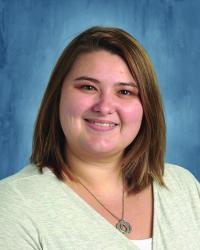Pathways to a Career in Secondary Education (It’s Not Too Late)
Fall
2024
Feature
Pathways to a Career in Secondary Education (It’s Not Too Late)
Justine Harren, Interim K12 Program Manager, American Association of Physics Teachers
C8 - Harren1.jpg

Justine Harren.
Fortunately, I was gifted with an advisor that didn’t see a reason why I couldn’t do both. She saw my ambition and helped me declare and complete majors in K–6 elementary education and 5–12 physics secondary education in only four years. Upon graduating with two bachelor’s degrees, I found myself in a high school classroom with 150 of my own students in an urban area outside of Minneapolis, Minnesota.
My path into education was fairly direct, because I knew from the start, with little doubt, that I wanted to teach. However, stories like mine are less common than you might think. The more high school physics teachers I get to know, the more unique stories I hear of entering the profession. I recently conducted a poll in physics teacher groups on social media, asking, “What was the path you took into teaching?” The comments were filled with different meandering stories. Some were similar to mine, but most were indirect routes—a series of unpredicted experiences and decisions that landed these teachers in the classrooms they lead today.
A notable group of paths the social media responses highlighted was alternative pathways to licensure. In some cases, you can begin a teaching career before earning an education degree or teaching certificate. One colleague shared her story with the nonprofit Teach For America (TFA). As a college junior majoring in physics, she realized that she no longer wanted to follow her original plan to pursue a PhD. She applied to Teach For America and was placed in a high school physics classroom in Detroit, Michigan. TFA helped her earn a master’s degree in education while working, and she is now a 10-year veteran of teaching! TFA is not the only option; different states have different teacher licensing programs, and many have alternative certification programs for those who didn’t pursue education as an undergraduate.
Another option for undergraduates who want to teach at the high school level or below is graduate school. It is not uncommon for people to earn a bachelor's of science in physics and then go to graduate school in education and get licensed to teach. I have a former intern who is currently completing this process. He entered his undergraduate studies interested in physics but unsure of teaching. He eventually realized he wanted to be in a classroom and is now finishing a master’s in education and seeking a classroom position for this fall. Although it takes a little longer, this pathway produces teachers with solid content knowledge from their undergraduate studies who received high-quality education training as graduate students. It's also worth noting that teacher salaries are often based on experience and level of education. A first-year teacher with a master’s degree will start higher on the pay scale than one without. In a field such as physics, where qualified candidates are limited, this can be a good benefit.
Recently, I was chatting with a preservice teacher in a science methods course I teach when she began telling me about her path into education. After high school, she initiated a career in culinary arts. She spent two years in the field before realizing she was more interested in working with people. She then earned a two-year degree in law enforcement and became a police officer. After a few years, she started looking for yet another option. Following an interim job as a paraprofessional in a school, she decided she was going back to school—for teaching this time. She is a bit older than many of her classmates and has the added challenge of balancing a family with coursework, but she will graduate in a few short months and will move into her own classroom. I look forward to checking back in a few years to see if education is her final landing place!
These stories from friends, colleagues, and students remind me of a conversation I had a few months ago. I was sitting with a professor from my alma mater, where I now adjunct, discussing possible joint interests. She shared a thought that continues to roll around in my mind, especially after my undergraduate experience. She explained that time and time again students tell her they are interested in teaching but think it is too late because they are two, three, or four years into their content program. This is simply not true! Students interested in teaching have many pathways into education, even after their undergraduate education. You don’t have to decide whether you want to be a teacher at age 18, and your college path does not pigeonhole you into or out of a career that you want. I hope to see this attitude change and renewed encouragement and support for people exploring their options at any point in their education or career.
The American Association of Physics Teachers is a professional scientific society dedicated to the pursuit of excellence in physical science education. To learn about its resources for students and teachers, visit aapt.org.
SPS members are eligible for a free year in AAPT when they register or renew. For details, visit spsnational.org/about/membership/free-ms-membership.
Teach For America finds, develops, and supports equity-oriented leaders to transform education and expand opportunity for all children. Learn more at teachforamerica.org.


